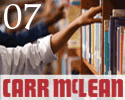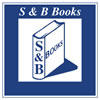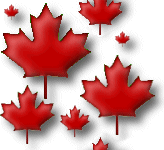“I Didn’t Know That Was Canadian!”
David Ward
David Ward is a children’s author and a doctoral student and instructor at the University of British Columbia. This article is reprinted with permission, from Alberta Voices, vol. 5, number 2, June 2006.
Issue Contents
______________________________________________________
While I was teaching a Canadian children’s literature course last spring, a student made a comment on the first day of class that captured the spirit of our collegiate journey: “I didn’t know that was Canadian.” She was referring to one of the many books displayed around the room. Several peers nodded in agreement and quickly the dialogue extended to other titles.
It was a remarkable conversation, particularly so, because the students were not elementary or even high school students: they were experienced teachers and teacher-librarians, working towards a diploma or Masters Degree in Education. The thirty-six educators in the room represented many different districts, cultures, and ranges of grades in which they taught.
In the months that followed, our class discussed almost three hundred Canadian books for children. We explored reviews from Resource Links, Alberta Voices, Canadian Review of Materials (CM), Quill and Quire, and read articles from the Canadian Journal of Education, School Libraries in Canada, Canadian Children’s Literature, and English Quarterly. Each student critiqued young adult novels, junior novels, information books, picture books, poetry and graphic novels. Several students were experienced teacher-librarians and their knowledge of Canadian children’s literature complemented and added greatly to the materials presented.
It was not long before a second question was raised – a question that elicited passionate responses from all of us: Why didn’t we know these books were Canadian? Many of the titles, covers, and authors were familiar, and yet, a majority of the class found surprises as they explored the literature presented around the room. Among the exclamations of, “That’s a good one!” or, “I’ve used that before,” were confessions such as, “I’ve had that in my room for three years and I never knew she (the author) was a Canadian.”
We took some time to introduce ourselves, and student after student described their unique district, region or school. Despite the varying demographics and administrative objectives within each school, patterns began to emerge from our dialogue: budgets, book selection, curriculum choices, administration, and library cutbacks. After each class I would sift through the conversations, the vivid descriptions of each school’s literacy tradition, wondering where this might lead us. As a children’s author and instructor of the course I found myself asking an additional question: does it matter if we know a book is Canadian?
As a researcher, I was certain that Canadian children’s literature played an enormous role in schools. Scholars have investigated the importance of Canadian children’s literature before (Pantaleo, 2002; Egoff & Saltman, 1990). Similarly, Canadian Children’s Literature produced a remarkable piece on “What’s Canadian about Canadian Children’s Literature? (Nodelman, 1997), which contributes a mosaic of interested voices to the discussion. My own research, conducted in 2004, reported on the phenomenon of author-mentorship, Canadian authors participating in significant literacy exchanges with students. Authors agreed that children connected profoundly with their stories and wanted to extend their experiences with the book by contacting the author (Ward, 2005). What also became clear is that who writes a story is significant. Many stories written by Canadians are not set in Canada . They may even be science fiction or fantasies on other worlds. Connections deepen when young readers discover the author’s nationality.
As a children’s author I knew first hand that children frequently asked how my personal history impacted my stories. During an author visit, I always read from manuscripts with Canadian settings and describe how my life in Canada has impacted my writing process. But what did these exchanges or any other interactions with national literature accomplish?
In a 2003 report on the importance of Canadian children’s literature, Katherine Foley, provided a significant starting point:
The understanding of Canada and Canadians can be enhanced by immersing our young people in the wonder found in books written by Canadians. Canadian authors have a passion for, and a belief in, the beauty found all across our country. They have authored books not only about the country they love but that tell the stories that reflect the diversity of the people of Canada , how they interact, their dreams and beliefs. The more all Canadian’s are exposed to the thoughts of others within our country, the more we will understand our similarities and differences, and be willing to work towards the common good for all people in Canada (Foley, 2003, p. 2).
Similarly, Mary Clare Courtland suggested that while our national children’s literature may have universal and international appeal, the, “authorship, content, settings, and characters in Canadian children’s literature evoke deeply personal connections for us,” (Courtland, 2000, 21).
As professional educators in a Canadian children’s literature course, we agreed with Foley and Courtland. Each of us could think of experiences in the classroom or library where children had united or found cultural connections through the reading of a story. The examples made me think of some of my academic experiences as well.
Roch Carrier came to speak at Serendipity 2005, a conference celebrating Canadian and international authors sponsored by the Vancouver Children’s Literature Roundtable. Sharing anecdotes about, The Hockey Sweater, he mentioned a boy who phoned him at his office at the National Library to express his love for Roch’s story. The child also invited him to his hockey game! Best of all, Roch went to the game.
Listening to Roch brought me back to my own roots of growing up in Montreal . I remembered the inculcated value of hockey in our family. I remembered the feel of hockey on an open ice rink. I remembered my own hockey sweater becoming too small for the first time.
Not all of the identifications our class made with Canadian books were pleasant. One student broke down and wept over a story that reminded her of the racist comments she suffered as a child immigrant to Canada . Books, such as Gayle Friesen’s, Men of Stone, remind us of the realities children face in and out of our schools. Such books also give us forums for discussion with the students in our classrooms, regardless of age, and allow us to express our differences, objections, similarities, and tensions while still under the same maple leaf flag. Canadian children’s literature can often perform a similar function to family meetings: where we relate our individualities to our unique national setting. We can express our beginnings, our current situations, and our future in this country together.
Thinking about the value of our literature reassured us as a class that our need to pursue the reasons for our lack of knowledge was, indeed, important. Those in the class with extensive backgrounds in Canadian literature, particularly the teacher-librarians, thought about their experiences with teaching colleagues, administrators, and school boards. Our shared experiences revealed a desire for Canadian children’s literature that was too often left unsatisfied due to overwhelming obstacles.
Through discussion we came up with four recurring themes:
- Canadian children’s literature courses were not a part of teacher-education or teacher-librarian pre-service training.
- More often then not, Canadian literature courses were weighted against courses that raised their resume profile.
- Budget cutbacks have paved the way for “essentials-only,” curriculum focused, purchasing of books and materials. Word of mouth and government recommended materials (curriculum-based) are at the top of the list for influencing selection.
- There is little identification of Canadian books in bookstores or libraries.
- Teacher-librarian positions have been drastically reduced. As educators, there is limited time to spend searching for books and it is safer to use the best known literature.
In 2004, the Association of Canadian Publishers released a report on Canadian books in school libraries. Their findings, summarized below, correlated with the experiences of professionals in our children’s literature course.
- “Over 90% of the teacher-librarians, teachers, principals, school districts, and ministries of education represented in the survey stated that it was important to have Canadian books in the school libraries, for reasons that included the relevance of Canadian books for student experience, the need to reflect Canadian culture and heritage, the need to provide Canadian perspectives with the pervasive influence of American culture, the need for students to know about Canadian authors and the high quality of Canadian books.”
- “Word of mouth, bookstores, and wholesalers, and reviews,” influenced book selection in school libraries.
- 65% of respondents (teachers, teacher-librarians, and administrators from across Canada ) said that lack of awareness of Canadian titles was a central barrier to having Canadian content in the classroom.
- 55% said a lack of budget was a significant reason for less national books on the classroom shelves.
- “Teacher-librarians are often champions of Canadian books: sourcing and building Canadian content in school library collections, reading review publications, arranging author visits, recommending titles for students and teachers, and running book award programs…In the pivotal early years when children are most likely to develop a love of reading to last a lifetime, their teacher-librarians are half-time or less.” (ACP, 2004).
The impact of these combined factors continues to be devastating on our school systems. The symbiotic nature of libraries, book sellers, authors, and schools is such that when one suffers, the rest suffer also. When more than one of these groups suffers a loss of funding, or faces cutbacks, disaster is close behind.
The selection of children’s books is an excellent example of the interdependent nature of the children’s book world. Selecting books is a daunting task for any educator. There are simply too many books to choose from. As the ACP report indicated, selection of Canadian books has often fallen into the hands of teacher-librarians. Cutbacks have reduced time for teacher-librarians to learn about new Canadian books and promote them in their schools. Without promotion, book sales go down, hurting publishers and forcing them to take fewer risks. As publishers feel the financial squeeze, so ultimately, do the authors.
I am part of a Canadian authors’ list-serve. Frequently, industry news will be the focus of discussion. Regional publishers in Canada , however large or small, are the bread-and-butter for most Canadian authors. When a publisher shuts down one of its divisions, or removes an editor, the ripple affect is felt by authors across the nation. Editors work with numerous writers, often developing a close relationship over the course of many years. The absence of a single editor can affect the production of books, the completion of contracts and the relationship of authors to their publishers. For authors, losing an editor can impact the direction of their writing career.
The final link in the symbiotic chain of the publishing cycle is, of course, the reader. As consumers, young readers tend to digest what they are presented at school, book stores, and libraries. If a certain genre is missing, others will be consumed. In some cases, young readers will simply stop reading for a time. Others will choose new material to read. Readers suffer their greatest losses by never knowing what they are missing.
As Canadian educators our class felt the need to supply our children with the literature of Canada . Does it matter if educators do not know their nation’s literature? Yes. Many of us discovered that our focus lay elsewhere, centred on constrains of curriculum, and the pain of budget cuts. Taking a course on Canadian children’s literature allowed us as colleagues to refocus, not only on the exceptional abilities of our writers, but also on rediscovering a most remarkable country – our own.
Why don’t we know Canadian children’s literature? As the research and our own collective experiences have shown, there are a number of key reasons:
- School libraries and the role of the teacher-librarian need to be celebrated as the heart of literacy in our country. The biggest supporters of our nation’s literature need the greatest support from government, school administrators, teachers, students and parents. We cannot know our country’s literature when its guardians have been removed.
- Our teacher education programs need to make Canadian children’s literature a core course. As new teachers enter the school system they will be more aware of Canadian literature and the reasons behind building national content in the classroom.
- Canadian books need to be identified in libraries, bookstores, and schools. Awareness, access, and promotion can help direct, remind, and encourage educators to bring Canadian literature into the classroom.
Our journey with Canadian children’s books was a delightful re-acquaintance with the authors, stories and fabrics of our country. Yet, the place of Canadian children’s literature in our schools left us a more sober group. The severity of the issues are serious. But we also emerged more determined. Awareness of quality Canadian children’s literature fostered a hunger for more. Talking about local and national authors invoked a considerable amount of interest. Most students expressed a desire to make Canadian children’s literature more of a focus in their classrooms.
As a children’s author I have had the privilege of meeting many teachers and teacher-librarians across Canada . These professionals know the value of literature and feel the need of sharing Canadian children’s literature in a plethora of creative ways. They have made extensive use of the World Wide Web to improve communication with library associations for keeping each other informed of the world of literacy. In my travels, however, I continue to see school libraries operating at life-support level and frequently receive emails that say, “David, can we book you on a Tuesday? My library position is only half time at this school.”
At the close of our course, each of us expressed the hope that the decades of effort made to infuse our national literature into our classrooms will not be wasted by educational trends or budgets, but that it will flourish as a rich source of Canadian identity and as one of the foundational sources to serve literacy programs in Canadian schools.
References:
Association of Canadian Publishers. (2004). Canadian Books in School Libraries: Raising the Profile. Toronto : Association of Canadian Publishers.
Egoff, Sheila ; Saltman, Judith.(1990). The new republic of childhood : a critical guide to Canadian children's literature in English. Toronto : Oxford University Press.
Courtland, M.C., & Gambell, T.J. (Eds). (2000). Young Adolescents Meet Literature: Intersections for Learning. Vancouver : Pacific Education Press.
Foley, K. (2003). Canadian Children’s Literature: Why do we need it? Retrieved January 5, 2005, from the University of British Columbia , School of Library , Archival & Information Studies, resume website: http://www.slais.ubc.ca/PEOPLE/students/resumes/K_Foley/kfoleyPortfolio/IndexKEF.htm
Nodelman, P. (1997). What’s Canadian about Canadian Children’s Literature?: A compendium of answers to the Question. Canadian Children’s Literature. 87 (23) 15-35.
Pantaleo, S. (2001b, September). Exploring Canadian identity through Canadian children's literature. Reading Online [On-line serial], 5 (2).
Ward, D. (2005). Writing Back: Authors affirming the next generation of Writers. Alberta Voices. Vol. 4 no. 1.
______________________________________________________
Copyright ©2006 Canadian Association for School Libraries | Privacy Policy | Contact Us
ISSN 1710-8535 School Libraries in Canada Online
|





Sponsors Welcome |
|
